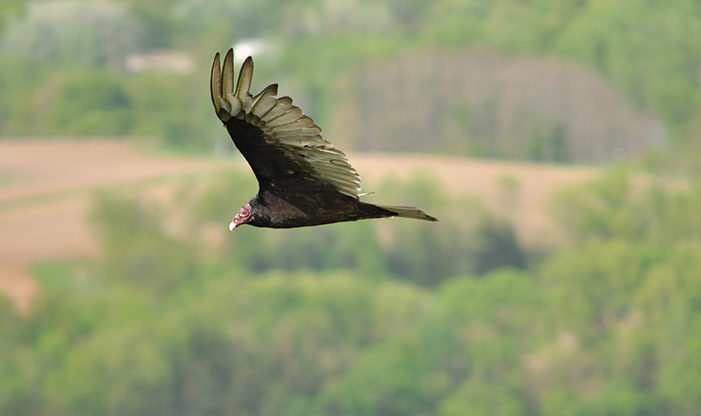Aptly named, Cathartes aura, “golden purifier or cleanser,” Turkey Vultures are perfectly outfitted as aerial scavengers, the niche they chose 65 million years ago. Their perforate nostril contains the largest scent organ of any bird and allows them to smell a potential meal from more than a mile away. An almost featherless long, narrow head and neck helps them stay clean while dining and soft feet hold down their meal. Turkey Vultures are covered with dark iridescent feathers that warm in the sun to kill bacteria hitching a ride after a meal. Their bright red face surrounds inquisitive eyes, and will change color if threatened.
Turkey Vultures in Wisconsin
Turkey Vultures were rarely seen in Wisconsin until the late 1940’s, when the newly created interstate highway began providing a reliable road kill food source. These birds coast thousands of feet into the sky on thermals (sun heated pockets of air), tilting side to side in circular formations called kettles. Then they coast back to earth, able to cover over 100 miles without a single flap. Efficiency is vital to the survival of a sharp eyed scavenger that doesn’t know when or where their next meal will be.
Turkey Vultures are Nature’s Composting Crew
The vulture’s most important tool is one you can’t see – their stomach. Vultures consume millions of pounds of decomposing animals that harbor pathogens and diseases (i.e hanta virus, cholera, anthrax), which could be dangerous to humans. Vultures ingest them, neutralize them in their guts and don’t excrete them. This is an enormous service to humans and other animals. They are a free, mobile composting crew.
Turkey Vultures are often judged by their choice in cuisine, but they provide an extremely valuable service. So the next time you see a gathering of vultures, which are called a wake, think of them as undertakers servicing the animal world.
Learn about Tallulah, the Center’s Turkey Vulture.


